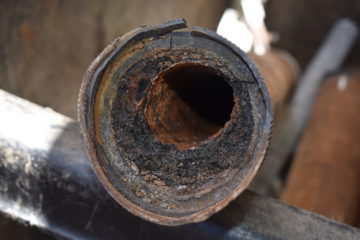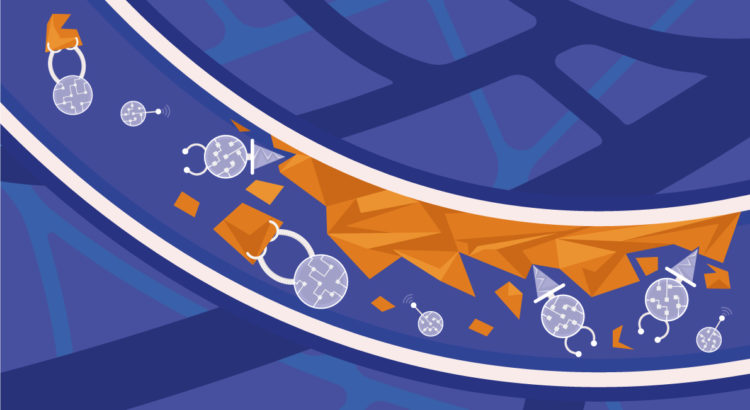The Future of Plumbing
Innovation is a curious thing. It happens in fits and starts, leaps and bounds, sometimes evolutionary and sometimes revolutionary. We see it daily, we experience it real-time; in our technology, in our society, and in our lives.
In many ways, innovation is front and center, in other areas it goes almost unnoticed. Take piping for instance: the concept of using a tubular vessel to carry water has been around since humans figured out how to make tubular vessels to carry water. From clay to metal to plastic, the material may have evolved, but the very nature of plumbing remains unchanged, to move water from one place to another.

So what are the next innovations that will reshape the future of plumbing? Is there any better way to actually carry water from one place to another? Who knows, but as specialists focused on replacing aged and defective plumbing systems, we certainly see some obvious areas for improvement, and are approached every day by the “next big thing” in the industry.
But what if we aren’t thinking outside the box as much as we should, or further enough into the future. What are the real possibilities? Well, here are some theories:
Current technologies that will evolve plumbing in the next 5 to 20 years
Sensors
From flow monitoring to remote controlled shut-off valves to water intrusion sensors, these technologies already exist, and it’s only a short matter of time before they become commonplace components of every piping system. Reporting when water is moving too fast, too hot, with too much pressure, or is showing up where it doesn’t belong is easily achievable by installing various sensors in and around your piping system that can report such information. As soon as you know a problem exists, the sensors can then be programmed to act on that information. Water is too hot, automatically cool it down; flowing to fast, reduce the pump rates; leaking, shut it off. Integrating computer technology and control systems into plumbing for both new construction and retrofits is a relatively easy task, and the costs are coming down every day. We predict it will soon be ubiquitous.
Materials
There is an almost infinite array of plastic composites that are available to scientists and inventors today. As research continues, advancements will be made and newer, better materials will continue to emerge in the marketplace, providing builders and homeowners with choices. From better insulating options (temperature and sound) to improved connections to fittings, new materials will drive some level of innovation within current piping systems and new piping systems that have yet to be conceived will emerge. Composites are even starting to appear with metal pipes, pre-lined at the factory with plastic resins to prevent corrosion, already available in the marketplace.
System Design
Environmental considerations are a chief driver in this area, and looking at more energy efficient and environmentally friendly ways to heat and cool water, and to get it to flow (against gravity) with less energy, will continue to shape and influence how plumbing systems are designed and function. Advances in centralization, decentralization, thermal conductivity and even material friction will all impact how systems are designed. Is it better to have decentralized systems with shorter pipe runs, or centralized systems with longer runs but more friction resistant surfaces (e.g., hydrophobic coatings)? Research, innovation, advanced modeling techniques and even artificial intelligence will all help answer these and other, far more complex, plumbing questions of the future.
But that’s all relatively predictable. The harder and more exciting question is what happens next? What hypothetical improvements will impact plumbing in 100 years or more?
The Future
As biology and technology continue on their march towards “The Singularity” (singularity.com), there is no doubt that new concepts in plumbing will emerge. Think “smart” pipes that can sense corrosion and deploy an army of nanobots to perform an autonomous repair from inside the pipe. Or “self-healing” pipes that can adjust their size and wall thickness based on temperature, pressure and velocity to better accommodate changes in behavioral use. Need bigger, stronger pipes in the morning when everyone in a high-rise apartment building is showering and getting ready for work, but smaller, thinner pipes mid-day when usage is down? Easy. How about adaptive, organic pipes that can literally grow new branches to re-route around clogs? Is it science fiction or could it really happen one day?

Is there an eventual end to piping? Who knows, but probably. Could localized, high-speed “condensators” that quickly pull water out of thin air replace the need for pipes altogether? Maybe? How about rapid biodegrading evaporators that dissolve and consume waste and then gasify directly into the atmosphere, eliminating the need for drains? Science fiction? Probably. Or, will we look back, 1,000 years from now, and marvel at the true genius of basic tubular plumbing, still going strong even after a millennia of evolutionary changes, simply moving water from one place to another?
Regardless of what plumbing innovations actually happen, there are three things we know are for sure: 1. Water is very important and truly essential to life. 2. Waste is bad and harmful if not handled properly (just read about the bubonic plague and plumbing issues during the dark ages. And 3. Until the next big thing comes along, pipes will continue to be used in residential construction, they will continue to age after installation, and when they do get old and start to fail, they will continue to require replacement. Until the future arrives, we all simply have to deal with that reality.


